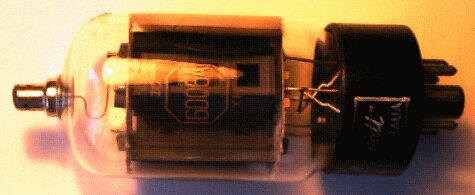These are not actually designed as audio valves but rather to superceed the 6CM5 in 23-inch Black and White TV line output stages (which explains the really berzerk several kilovolt peak rating of the anode.)
Amp builders loved 'em because they could make the magically fashionable 60 watts, as a beam pentode (having beam-forming plates rather than a conventional wire screen grid like the 6CA7) they were very physically robust on the road gigging, and best of all they were cheap and available in every suburban and town TV repair shop; handy if you happen to bust one gigging out the back of Lower Bandiwallop.
Then came colour TV's with their solid-state triplers, and they stopped making 6DQ6's.
One sort-of answer is to fit 6CM5's, the earlier line output valve. These were also made by the ton and like the 6DQ6 there are still a lot of originals hanging around as New Old Stock or NOS, meaning manufactured back in the day, but never been put into service.
But the central problem with having to buy NOS for guitar amp output valves is that they aren't making any more of them, and guitar amps tend to use output valves like a car uses tyres.
Due to a twist of history there are a several types of audio power valves that are still being manufactured and are available brand new, in particular the 6CA7/EL34, and the 6L6GT.
So the question keeps arising, can a 6DQ6 amp be converted to take a currently manufactured valve, if so which one, and how?
The major difficulty in giving a straight answer to these questions is that the 6DQ6 was never intended for audio application, so none of the databooks give typical operating conditions, as they do for say 6L6's, to compare.
So I have assembled a table of the actual operating conditions of the two amps most in question, the Goldie and the Playmaster (but will also apply to the Maton's, &c) alongside the databook typical conditions for the 6CA7, 6L6, and the 6146.
| GT(1759)/6DQ6 | PM117/6DQ6 | 6CA7/EL34 | 6L6GT | 6146 | |
|---|---|---|---|---|---|
| Vsup | 360 | 380 | 375 | 360 | {760} |
| Va | 350 | - | 350 | - | 750 |
| Ia mA | - | 2x 50-100+ | 2x 35-120 | 2x 88-102.5 | 2x 23-220 |
| Rl p-p | - | 2k6 | 2k8 | 3k8 | 8k |
| Po W* | 60 | 55 | 44 | 47 | 120 |
| Rg2 ohm | 2x 47 | 2x 47 | 1x 470 | - | - |
| Ig2 mA | - | - | 2x 4.7-25 | 2x 2.5-8 | 2x 1-26 |
| Vg2 | 180 | 190 | (~350) | 270 | 195 |
| Vg1 | -34/-36 | -38 | -32 | -22.5 | -50 |
| Ih Amp | 2x 1.2 | 2x 1.2 | 2x 1.5 | 2x 0.9 | 2x 1.25 |
* Note; (except 6146) the amp powers are taken at a higher distortion level than the datasheet powers, say 10% THD against 2%, so they are all effectively equal.
New: 11/12/10. It now looks like the 6146 is the best option for a 6DQ6B substitute. It is likely that the 6146 will return similar figures under similar conditions to a 6DQ6B, but with an enhanced life from being under-run.
From this table it would seem that 6CA7's are a suitable substitute, provided we take care of;
- rewiring the anodes to the base
- modifying the screen supply
- reducing the bias somewhat
Note that a pair of 6CA7's will draw over half an amp more heater current than 6DQ6's, and it have to be determined in each case if the heater supply will cope.
Base wiring
6DQ6
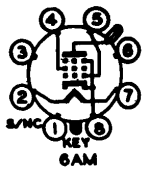
|
6CA7
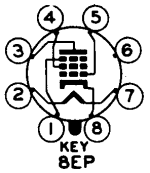
|
6L6
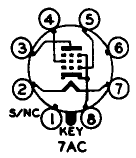
|
6146
TC a 1 k, g3 2 h 3 g2 4 k, g3 5 g1 6 k, g3 7 h 8 Shield Base: 7CK |
No serious traps here. What is a “Screen or No Connection” on pin 1 will need to be grounded for a 6CA7, and can best be tied to the cathode on pin 8 next door.
Naturally the anode lead to the transformer will need to be brought below-chassis and wired to respective pins 3, and will no doubt have to be extended and suitably insulated with heatshrink or full-length sleeving.
In the screen circuit on pins 4 there will be a 47 ohm connected to each from the existing screen supply. Instead, both screens must be fed from a single 470 ohm resistor direct to the main HT (output transformer center-tap).
R=470 R = 470 mA=0.05 mA = 0.05 ' P=I^2R P=mA^2*R P = 1.175
So use a 5 watt wirewound, and expect it to get warm under drive.
The Curves
“The 6DQ6A is a power valve used primarily as a power amplifier for horizontal deflection in television receivers. Because of volume of production, it is comparatively inexpensive.
As an output valve, the plate characteristics are not greatly different from those of the more familiar audio types such as the EL34 and the 6CA7.”
Playmaster 116 - Anthony Leo, June 1967 Electronics Australia
I guess that depends on what you understand by “greatly”. Here the anode characteristics of the 6DQ6 (solid) and the 6CA7 (dotted) are superimposed;
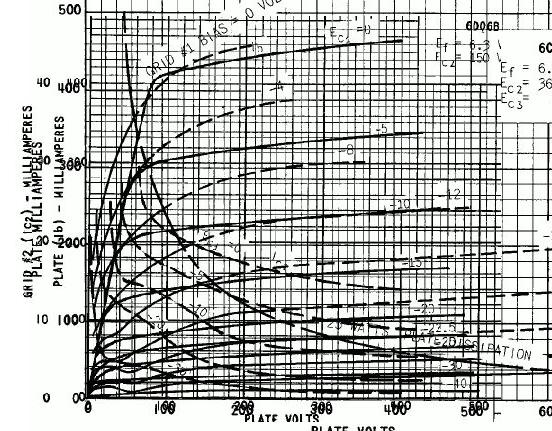
Generally speaking the 6CA7 curves are smoother and less kinky than those for the 6DQ6. This suggests that 6CA7 should be cleaner and have lower distortion than the 6DQ6.
What about the load?
Isn't the plate-to-plate load critical? Well, ... no actually.
In this case it's pretty darn close, but the main difference exact matching makes is screwing the last available watt out of a pair of valves.
Once Apon A Time the only thing that guitarists cared about was being loud, so the only thing that techs cared about was tweeking for maximum smoke. But times have changed and guitarists don't favor Goldie's, Playmaster's and Maton's these days for muscle, they like the tone.
And it turns out that there is an argument that one of the sources of “good tone”, a certain type of distortion, is a bit of a mismatch in the output stage, in particular below the optimum value.
But one important point: if you do modify any amplifier to take a valve other than the original, make sure this is clearly marked next to the sockets where it can't be missed, like “MODIFIED - 6CA7/EL34 ONLY!”
